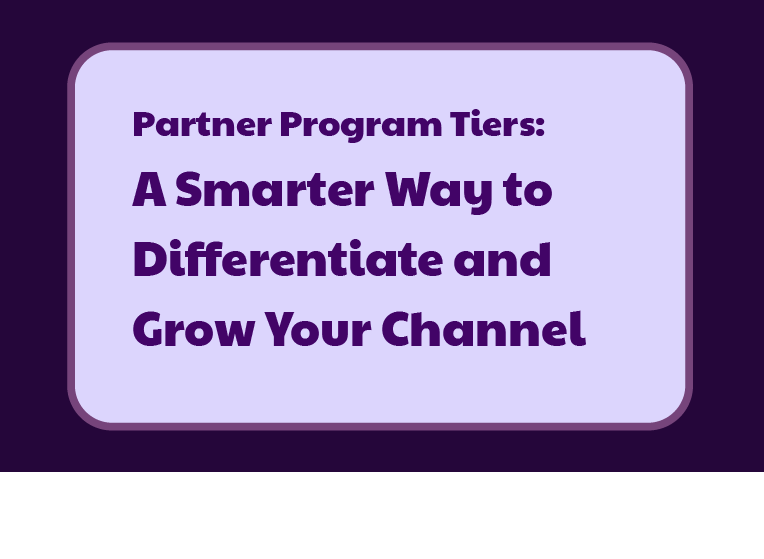Improving the Odds of Partners Engaging with Your Partner Portal: Addressing 4 Complaints (& Solutions)
Low partner engagement rates often stem from the experience vendors offer. It's crucial to provide personalized partner experiences, delivered through all touchpoints.
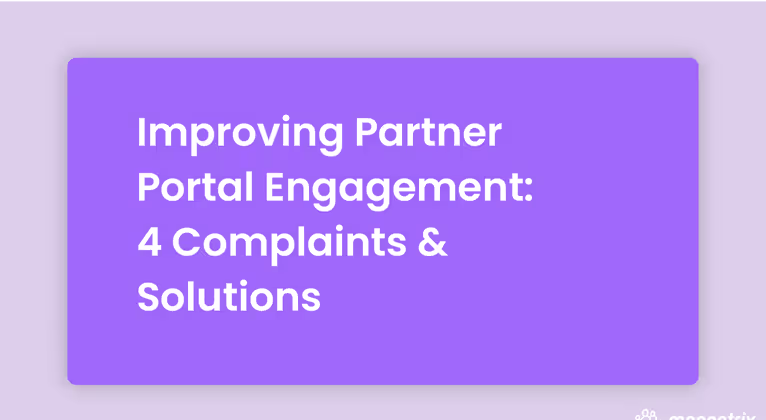
Table of Contents 📋
Table of Contents 📋
Is it really a lack of partner engagement in your portal? Or is it a case of unengaged vendors who don’t set up the partner for success in the portal, combined with poor portal functionality?
TL;DR: Partner portals are not dead. But why are partners not using your portal or logging in? Because partner engagement with your portal starts with the partner experience (PX) you give them in your partner program.
→ The best way to foster higher engagement is to provide personalized experiences. People pay attention when they see you’re tailoring the experience just for them.
→ And the PX you create should be consistently delivered through ALL touchpoints with partners. This means, this standard should extend to all aspects of your partner portal too.
Partner engagement within the portal isn’t a general problem with PRMs. If your partners are relatively engaged with your partner program but are not inclined on logging into the portal – then, it’s most likely you, the vendor, who hasn’t properly set up the portal, resulting in a poor user experience for partners. When this is further affected with a lack of overall functionality or personalization features within the PRM portal software itself, it’s really no wonder why partners aren’t keen on coming to your portal.
- The solution involves a 3-pronged approach:
- Part 1: First, make sure your partner program doesn’t suck: make sure it’s attractive, valuable and is meeting partner expectations
- Part 2: Select a capable PRM
- Part 3: Ensure you take the time to set it up for a good partner experience
- To deliver a great PX (and ensure you can do it at scale down the line), make sure the PRM you choose has these:
- An abundance of out-of-the-box functionality, features and capabilities tailored towards personalizing the partner experience
- And can further adapt to your requirements (portal software that’s built as an actual platform model - a PaaS - will really help you out here).
- Bonus: Gives your partners multiple ways to register leads, both inside and outside the portal (without logging in)
- Once you have the right tech, which includes all the tools you’ll need, the job’s not done. You now have to set it up so it’s as intuitive as breathing – giving partners a simple user experience. Read on for more on this.
- Partner tech is no different than other technology – leaving good impressions are all about a good UX (UI helps too of course).
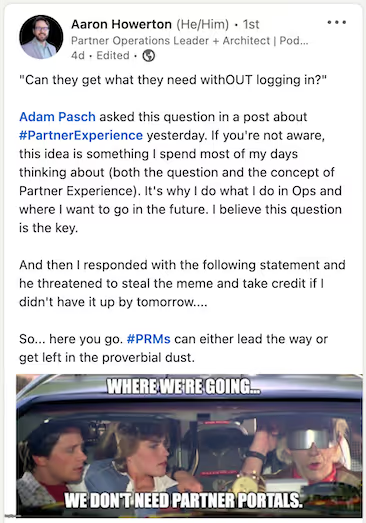
We all know the tried-and-true clickbait formula of “[xyz Topic/Technology] Is Dead!”
Well, every now and again, someone, somewhere comes out and makes a bold (but misguided) claim that partner portals are no longer relevant and will soon cease to exist.
This claim is now getting as old as the phrase "the check is in the mail."
We’re going to address the real culprit behind this claim: a lack of know-how, effort from the vendor, and an easy, intuitive user experience for the partner (partner experience).
Specifically, here are some partner engagement challenges we’re currently hearing from the market. We’ve outlined the potential solution to each challenge:
Partners: “We don’t want to log in to the portal.”
Solution

First of all, let’s be realistic. Can we really expect to not log into portals anymore?
Whether it’s a partner portal or your banking portal, if there’s security and confidential information involved (as is usually the case with partnerships), chances are, you’ll need to access a place where that information is kept private and secure.


But if partners really don’t want to log in, enable them with a PRM and other partner tech that provides a more convenient experience for them.
Find technology that allows partners to complete tasks without logging in:
- Submit leads to you without logging in to the portal
- Use Automations features in your PRM to alert them of information without making them log in to check it
- Retrieve resources or ask questions by opening up a PRM-connected chatbot in systems they use frequently (e.g. Gmail, Slack, etc.)
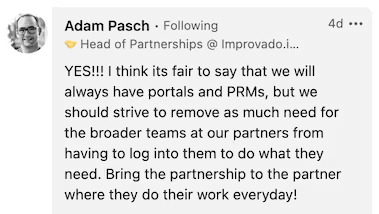
Magentrix partner management tech: Pioneer of AI-powered PRMs
This is where Magentrix is leading the way.
Being the first PRM to infuse the power of AI into our platform, we’re just getting started on revolutionizing partner tech.
In the current market state (and any time really), vendors should be making it as easy as possible for partners to engage and thus, should be trying as much as possible to meet partners where they already are – and Magentrix is not only helping make this a reality but we’re making it the new standard in partner tech.
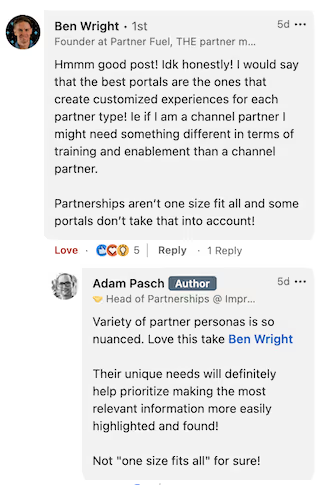
Solution
Agreed. You heard it from us first. Similar to how not all PRMs are meant for the same purpose (see screenshot below), a vendor shouldn’t take a one-size-fits-all type of approach to setting up their partner portal.

This is where ensuring you have capable partner tech plays an important role. A PRM with an arsenal of features and capabilities geared towards a personalized partner experience can help vendors tailor their engagement strategies to specific partner needs.
Some examples of how to provide such an experience may include:
A full PRM system can allow vendors to segment their partners based on various criteria, such as partner type, geographic location, or performance metrics. By segmenting partners, vendors can create tailored communication and engagement strategies that address each partner's specific needs and goals.
Create “personal experience” pages within your PRM and include customized dashboards that highlight the resources and tools that are most relevant to each partner's needs.
Personalization capabilities can also extend to training and support materials. Avoid providing general materials to each partner. Take some time to provide partners with access to learning resources that are tailored to their specific needs and skill levels. This can include: online courses, webinars, and other resources that are designed to help partners improve their performance and achieve their specific goals.
Try looking for a PRM that’s built as a platform as a service aka a PaaS (not just a plain old SaaS) to get even more flexibility and customizability. Why is this important? A portal built on a PaaS allows vendors to build and customize their portal on top of the platform, enabling them to tailor it to their specific needs and integrate it with other systems or applications. This level of customization and integration is not possible with a SaaS model, where vendors are limited to the features and functionality provided by the portal provider.
And sometimes it may not be obvious which features of your PRM can be used to tailor the partner experience. Take a look at how one vendor here approaches customizing the partner experience with a Wiki:
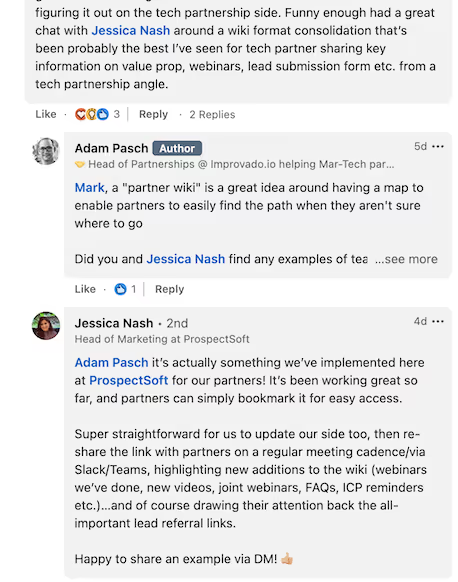
Bonus: Tailoring your engagement strategies to specific partner needs also happens to be a great way to build trust and loyalty with them.
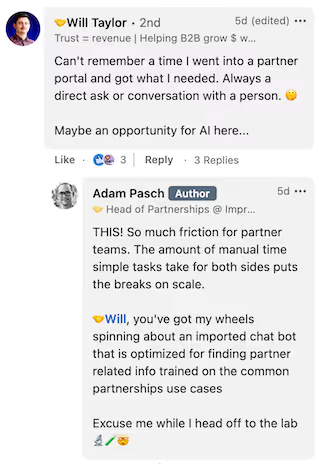
Solution
This is another issue that could be less painful to navigate if vendors take the time to set up their portal properly. It can lead to frustration and can negatively impact partner engagement and satisfaction.
To address this, there are many things to keep in mind when setting up or maintaining the portal.
Such as:
Ensuring that resources and information are clearly labeled and easily accessible, with intuitive navigation and search functionality.
Vendors should also consider categorizing resources and materials by partner type, skill level, or other relevant criteria to help partners find what they need more quickly.
Regularly review and update information and resources to account for relevance and timeliness. This can include removing outdated materials and adding new resources as needed.
Make use of your PRM’s features meant for exactly this purpose - providing an easy, more intuitive partner experience.
Use PX-specific features to help guide your partners through the portal. Such as:
- Engagement Pages
- Pop-up Alerts
- Email Automations
- Journey Builder
Don’t make partners dread logging in when they need something. Or better yet, enable them to get what they need without having to log in (see complaint #1).
Nobody likes a learning curve to new technologies (or existing technologies in this case).
Even in other areas of life, we want to be able to just dive in and intuitively be able to navigate towards what we need (think: throwing away the instructions manual when you get new IKEA furniture).
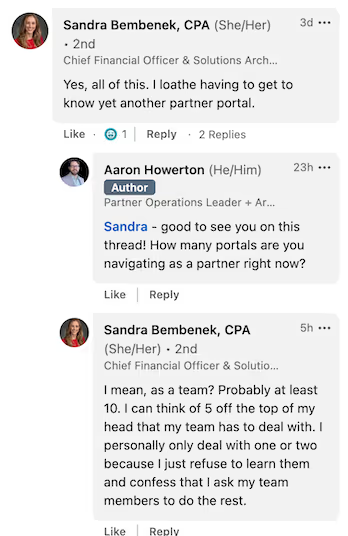
Solution
This one’s on the vendor. Think about it for a second. What does this vendor really hate about logging in?
She tells us - she doesn’t want to learn it and find her way around. This is probably because it’s usually been a pain for her to do so in the past.
Create a partner journey within the portal that’s intuitive and doesn’t leave the partner wondering about the important things such as:
- What they should do in there
- Where they should navigate to next
- Where to find the tools and resources they need
- Or how to self-serve
Remember, if your portal doesn’t have enough flexibility to customize it to your partner’s needs and prevents you from delivering a smooth partner experience, then you’re using the wrong PRM for your needs (or rather, for your partners’ needs).
Magentrix offers several features and capabilities to help with customizing the partner experience and further to that, anything it doesn’t offer may still be possible given that it’s built as a PaaS (as mentioned in detail under Complaint #2).
Partner portals are still relevant, but if your partners are not using your portal or even engaging with your partner program, it may be due to the partner experience (PX) you’re providing (whether that issue stems from within your portal or much earlier, within your partner program).
The lack of engagement with partner portals is often due to poor setup and a subpar user (partner) experience, compounded by a lack of functionality or personalization features within the PRM portal software itself. To increase the likelihood of engagement, it's crucial to provide personalized experiences that are consistently delivered throughout several touchpoints.
It's essential to invest in a well-designed and functional PRM that enables you to provide an excellent partner experience, and take the time to set up and maximize your usage of its personalization capabilities.
Don’t offer a subpar partner experience and expect partners to engage with you. Request or schedule a demo to see how Magentrix PaaS PRM can help you solve the personalization hurdles within the partner experience you’re providing.
---------------
More resources: If you enjoyed this article, we took to a bigger platform to continue the discussion behind the social posts featured in this article. To hear the conversation, which encompasses several POVs, see here: The State of Partner Engagement and Partner Portals in 2023 & Beyond




